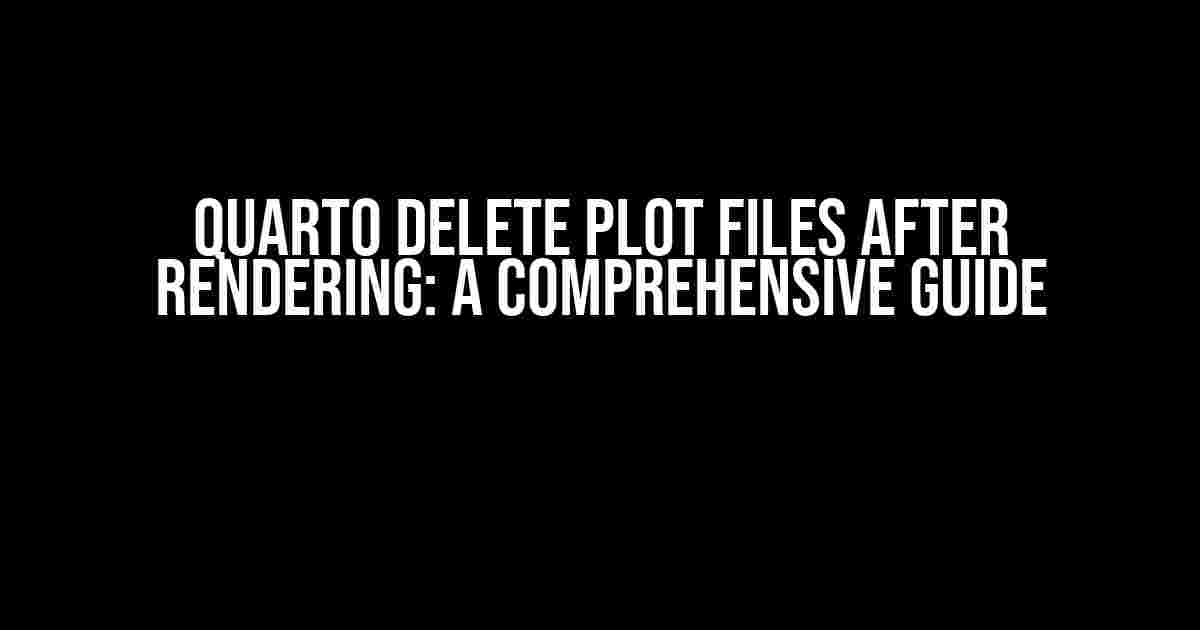Are you tired of cluttered project directories and excessive storage usage due to numerous plot files generated by Quarto? Do you want to learn how to delete plot files after rendering and keep your workspace organized? You’re in the right place! In this article, we’ll delve into the world of Quarto and explore various methods to delete plot files after rendering, ensuring a clutter-free and efficient workflow.
Understanding Quarto and Plot Files
Quarto is a powerful open-source publishing system that allows users to create reproducible documents, reports, and presentations. One of its key features is the ability to generate plots and visualizations from various data sources. However, this feature can sometimes lead to an accumulation of plot files, taking up valuable storage space and making it challenging to navigate your project directory.
Why Delete Plot Files After Rendering?
There are several reasons why deleting plot files after rendering is beneficial:
- Storage Space Savings**: By deleting unnecessary plot files, you can free up significant storage space, ensuring that your project directory remains organized and clutter-free.
- Improved Workflow Efficiency**: Deleting plot files after rendering helps you focus on the output files that matter, reducing the noise and distractions caused by numerous intermediate files.
- Version Control Simplification**: When working with version control systems like Git, deleting plot files after rendering simplifies the tracking and management of changes to your project.
Methods to Delete Plot Files After Rendering
Now that we’ve established the importance of deleting plot files after rendering, let’s explore the various methods to achieve this goal:
Method 1: Using the `–clean` Flag
The `–clean` flag is a built-in Quarto feature that allows you to delete intermediate files, including plot files, after rendering. To use this method, simply add the `–clean` flag to your Quarto command:
quarto render --clean your_document.qmdThis method is convenient, but it has some limitations. For instance, it only deletes files generated during the current rendering process, leaving behind files from previous renderings.
Method 2: Using a `clean` Script
This method involves creating a custom script that deletes plot files after rendering. You can create a file named `clean.sh` (or `clean.bat` on Windows) with the following contents:
#!/bin/bash
rm -rf ./plots/*
Make the script executable by running `chmod +x clean.sh` (or `chmod +x clean.bat` on Windows). Then, add the following line to your Quarto configuration file (`quarto.yml` or `quarto.yaml`):
after_render: ["./clean.sh"]This method provides more flexibility than the `–clean` flag, as you can customize the script to delete specific files or folders.
Method 3: Using a Quarto Extension
Quarto extensions are custom scripts that can be executed during the rendering process. You can create a custom extension to delete plot files after rendering. Create a file named `delete_plots.lua` with the following contents:
local function delete_plots()
local plot_dir = "plots"
local files = fs.readdir(plot_dir)
for _, file in ipairs(files) do
fs.remove(path.join(plot_dir, file))
end
end
quarto.after_render(delete_plots)
Add the following line to your Quarto configuration file (`quarto.yml` or `quarto.yaml`):
extensions: ["./delete_plots.lua"]This method provides a high degree of customization, as you can modify the script to delete specific files or folders based on your project’s requirements.
Best Practices for Deleting Plot Files After Rendering
To ensure a smooth and efficient workflow, follow these best practices when deleting plot files after rendering:
| Best Practice | Description |
|---|---|
| Organize your project directory | Keep your project directory organized by creating separate folders for input files, output files, and intermediate files. |
| Use meaningful file names | Use descriptive file names for your plots, making it easier to identify and delete unnecessary files. |
| Set up a consistent workflow | Establish a consistent workflow for deleting plot files after rendering, ensuring that your project directory remains organized and clutter-free. |
| Regularly clean up your project directory | Schedule regular cleanups of your project directory to remove unnecessary files and ensure that your workflow remains efficient. |
Conclusion
With Quarto’s flexibility and customization options, you can tailor your workflow to meet your specific needs. By deleting plot files after rendering, you’ll save storage space, improve workflow efficiency, and simplify version control. Start organizing your Quarto project directory today and take your productivity to the next level!
Frequently Asked Question
Quarto delete plot files after rendering? Let’s dive into the most frequently asked questions about this topic!
Why does Quarto delete plot files after rendering?
Quarto deletes plot files after rendering to keep your project organized and free from clutter. This feature helps maintain a tidy workspace, making it easier for you to focus on your project’s content rather than manage unnecessary files.
Can I prevent Quarto from deleting plot files after rendering?
Yes, you can! Quarto provides an option to retain plot files by setting the `keep-plot-files` option to `TRUE` in your Quarto configuration file. This way, you can keep your plot files for future reference or use.
What are the benefits of letting Quarto delete plot files after rendering?
By allowing Quarto to delete plot files, you’ll experience a faster project compile time, reduced storage usage, and a more streamlined workflow. This feature helps you stay focused on creating high-quality content rather than managing file clutter.
Does Quarto delete all types of files after rendering?
No, Quarto only deletes plot files generated during the rendering process. Your original source files, such as Markdown or R code, remain intact and unchanged.
How can I retrieve deleted plot files in Quarto?
Unfortunately, once Quarto deletes plot files, they are permanently removed and cannot be retrieved. However, you can always re-render your project to regenerate the plot files. If you need to retain plot files, consider setting the `keep-plot-files` option to `TRUE` to preserve them.



